Examining Gender Equality and Diversity in Leadership at Asda
VerifiedAdded on 2023/01/06
|34
|8363
|37
Project
AI Summary
This research project delves into the critical issue of gender equality and diversity within the workplace, using Asda as a case study. The project begins with an introduction outlining the background and rationale for the study, emphasizing the complexities of gender inequality within organizational structures, practices, and processes. A literature review explores the concepts of equality and diversity, the need for legal policies, and the issues Asda faces concerning gender inequality in leadership and management. The research methodology is then presented, followed by data analysis and interpretation, with the research outcomes and conclusions presented, along with recommendations for Asda to promote gender equality. The project aims to examine the effectiveness of legal considerations and policy development for managing gender equality in leadership and management, addressing research questions related to equality, diversity, legal policies, and the impact on business performance. The project's findings are supported by extensive references and an appendix. This project is contributed by a student to be published on the website Desklib.
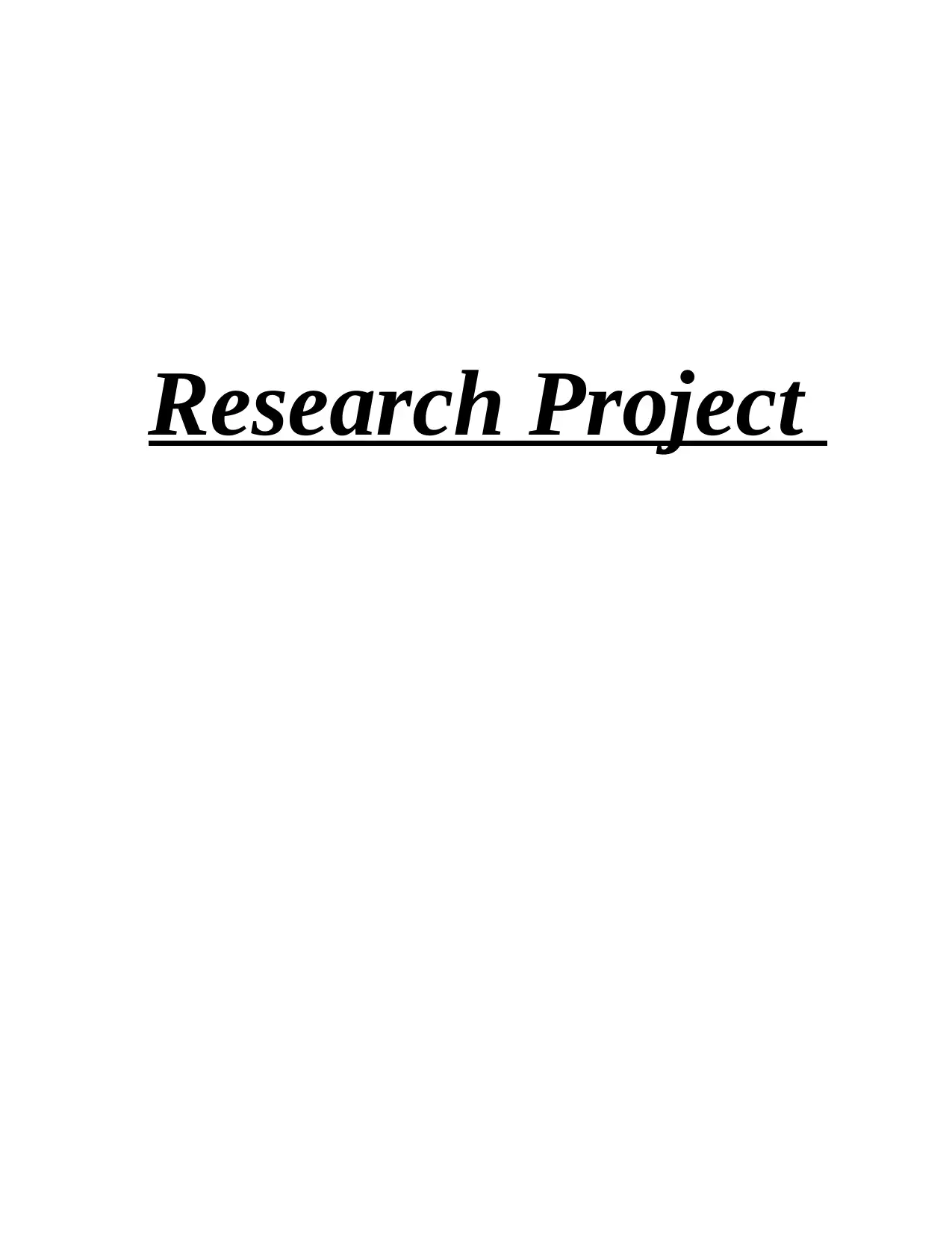
Research Project
Paraphrase This Document
Need a fresh take? Get an instant paraphrase of this document with our AI Paraphraser
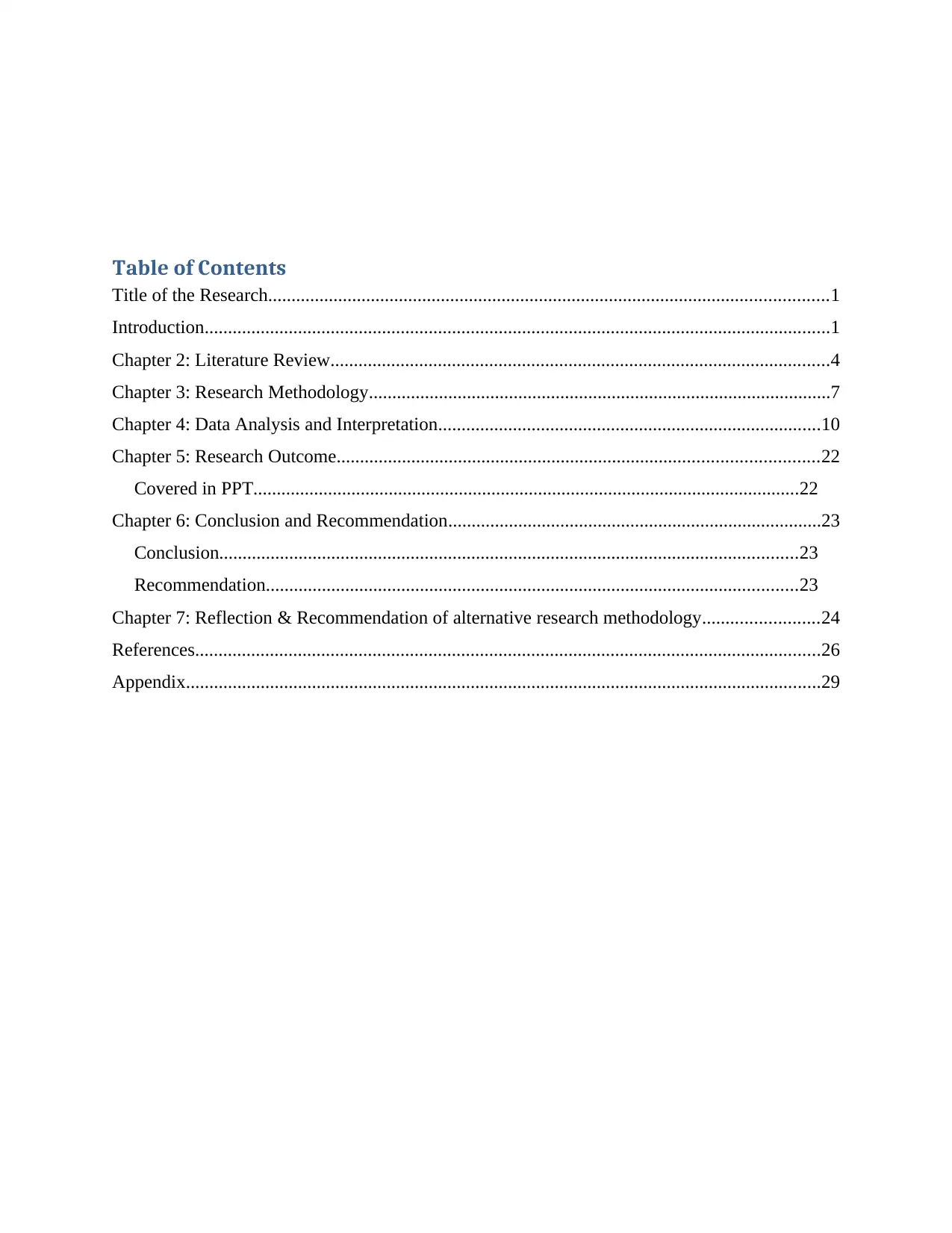
Table of Contents
Title of the Research........................................................................................................................1
Introduction......................................................................................................................................1
Chapter 2: Literature Review...........................................................................................................4
Chapter 3: Research Methodology...................................................................................................7
Chapter 4: Data Analysis and Interpretation..................................................................................10
Chapter 5: Research Outcome.......................................................................................................22
Covered in PPT.....................................................................................................................22
Chapter 6: Conclusion and Recommendation................................................................................23
Conclusion............................................................................................................................23
Recommendation..................................................................................................................23
Chapter 7: Reflection & Recommendation of alternative research methodology.........................24
References......................................................................................................................................26
Appendix........................................................................................................................................29
Title of the Research........................................................................................................................1
Introduction......................................................................................................................................1
Chapter 2: Literature Review...........................................................................................................4
Chapter 3: Research Methodology...................................................................................................7
Chapter 4: Data Analysis and Interpretation..................................................................................10
Chapter 5: Research Outcome.......................................................................................................22
Covered in PPT.....................................................................................................................22
Chapter 6: Conclusion and Recommendation................................................................................23
Conclusion............................................................................................................................23
Recommendation..................................................................................................................23
Chapter 7: Reflection & Recommendation of alternative research methodology.........................24
References......................................................................................................................................26
Appendix........................................................................................................................................29

⊘ This is a preview!⊘
Do you want full access?
Subscribe today to unlock all pages.

Trusted by 1+ million students worldwide
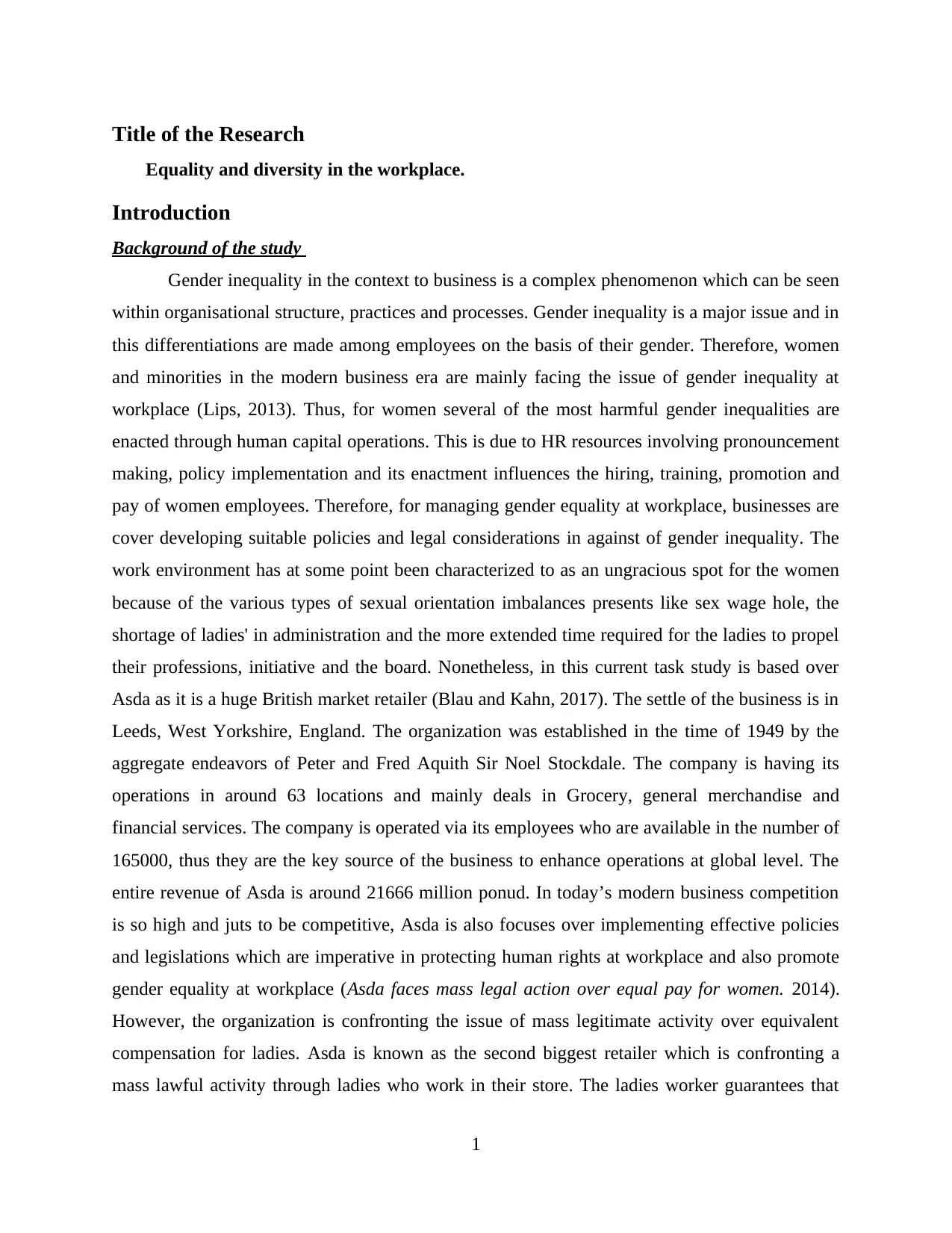
Title of the Research
Equality and diversity in the workplace.
Introduction
Background of the study
Gender inequality in the context to business is a complex phenomenon which can be seen
within organisational structure, practices and processes. Gender inequality is a major issue and in
this differentiations are made among employees on the basis of their gender. Therefore, women
and minorities in the modern business era are mainly facing the issue of gender inequality at
workplace (Lips, 2013). Thus, for women several of the most harmful gender inequalities are
enacted through human capital operations. This is due to HR resources involving pronouncement
making, policy implementation and its enactment influences the hiring, training, promotion and
pay of women employees. Therefore, for managing gender equality at workplace, businesses are
cover developing suitable policies and legal considerations in against of gender inequality. The
work environment has at some point been characterized to as an ungracious spot for the women
because of the various types of sexual orientation imbalances presents like sex wage hole, the
shortage of ladies' in administration and the more extended time required for the ladies to propel
their professions, initiative and the board. Nonetheless, in this current task study is based over
Asda as it is a huge British market retailer (Blau and Kahn, 2017). The settle of the business is in
Leeds, West Yorkshire, England. The organization was established in the time of 1949 by the
aggregate endeavors of Peter and Fred Aquith Sir Noel Stockdale. The company is having its
operations in around 63 locations and mainly deals in Grocery, general merchandise and
financial services. The company is operated via its employees who are available in the number of
165000, thus they are the key source of the business to enhance operations at global level. The
entire revenue of Asda is around 21666 million ponud. In today’s modern business competition
is so high and juts to be competitive, Asda is also focuses over implementing effective policies
and legislations which are imperative in protecting human rights at workplace and also promote
gender equality at workplace (Asda faces mass legal action over equal pay for women. 2014).
However, the organization is confronting the issue of mass legitimate activity over equivalent
compensation for ladies. Asda is known as the second biggest retailer which is confronting a
mass lawful activity through ladies who work in their store. The ladies worker guarantees that
1
Equality and diversity in the workplace.
Introduction
Background of the study
Gender inequality in the context to business is a complex phenomenon which can be seen
within organisational structure, practices and processes. Gender inequality is a major issue and in
this differentiations are made among employees on the basis of their gender. Therefore, women
and minorities in the modern business era are mainly facing the issue of gender inequality at
workplace (Lips, 2013). Thus, for women several of the most harmful gender inequalities are
enacted through human capital operations. This is due to HR resources involving pronouncement
making, policy implementation and its enactment influences the hiring, training, promotion and
pay of women employees. Therefore, for managing gender equality at workplace, businesses are
cover developing suitable policies and legal considerations in against of gender inequality. The
work environment has at some point been characterized to as an ungracious spot for the women
because of the various types of sexual orientation imbalances presents like sex wage hole, the
shortage of ladies' in administration and the more extended time required for the ladies to propel
their professions, initiative and the board. Nonetheless, in this current task study is based over
Asda as it is a huge British market retailer (Blau and Kahn, 2017). The settle of the business is in
Leeds, West Yorkshire, England. The organization was established in the time of 1949 by the
aggregate endeavors of Peter and Fred Aquith Sir Noel Stockdale. The company is having its
operations in around 63 locations and mainly deals in Grocery, general merchandise and
financial services. The company is operated via its employees who are available in the number of
165000, thus they are the key source of the business to enhance operations at global level. The
entire revenue of Asda is around 21666 million ponud. In today’s modern business competition
is so high and juts to be competitive, Asda is also focuses over implementing effective policies
and legislations which are imperative in protecting human rights at workplace and also promote
gender equality at workplace (Asda faces mass legal action over equal pay for women. 2014).
However, the organization is confronting the issue of mass legitimate activity over equivalent
compensation for ladies. Asda is known as the second biggest retailer which is confronting a
mass lawful activity through ladies who work in their store. The ladies worker guarantees that
1
Paraphrase This Document
Need a fresh take? Get an instant paraphrase of this document with our AI Paraphraser
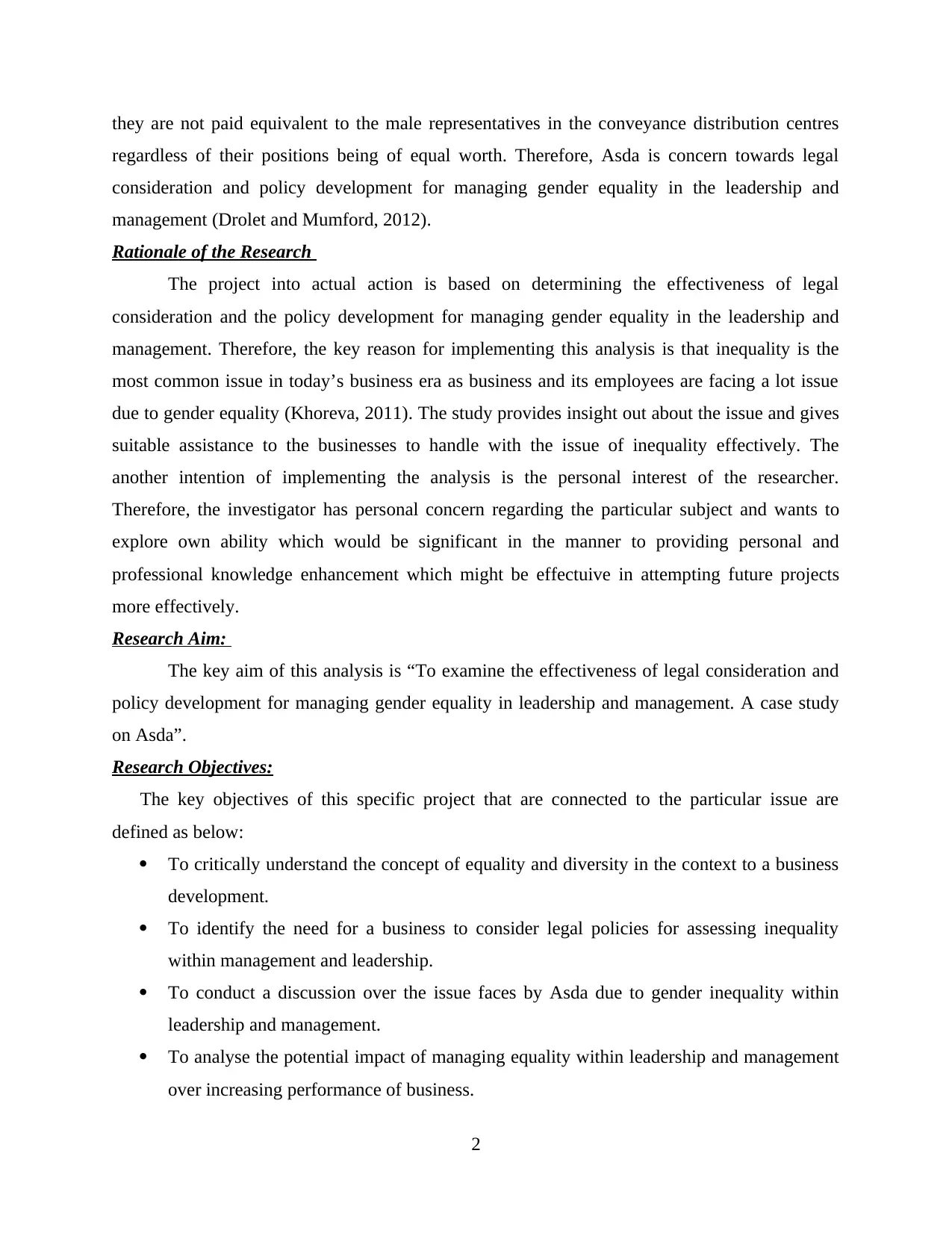
they are not paid equivalent to the male representatives in the conveyance distribution centres
regardless of their positions being of equal worth. Therefore, Asda is concern towards legal
consideration and policy development for managing gender equality in the leadership and
management (Drolet and Mumford, 2012).
Rationale of the Research
The project into actual action is based on determining the effectiveness of legal
consideration and the policy development for managing gender equality in the leadership and
management. Therefore, the key reason for implementing this analysis is that inequality is the
most common issue in today’s business era as business and its employees are facing a lot issue
due to gender equality (Khoreva, 2011). The study provides insight out about the issue and gives
suitable assistance to the businesses to handle with the issue of inequality effectively. The
another intention of implementing the analysis is the personal interest of the researcher.
Therefore, the investigator has personal concern regarding the particular subject and wants to
explore own ability which would be significant in the manner to providing personal and
professional knowledge enhancement which might be effectuive in attempting future projects
more effectively.
Research Aim:
The key aim of this analysis is “To examine the effectiveness of legal consideration and
policy development for managing gender equality in leadership and management. A case study
on Asda”.
Research Objectives:
The key objectives of this specific project that are connected to the particular issue are
defined as below:
To critically understand the concept of equality and diversity in the context to a business
development.
To identify the need for a business to consider legal policies for assessing inequality
within management and leadership.
To conduct a discussion over the issue faces by Asda due to gender inequality within
leadership and management.
To analyse the potential impact of managing equality within leadership and management
over increasing performance of business.
2
regardless of their positions being of equal worth. Therefore, Asda is concern towards legal
consideration and policy development for managing gender equality in the leadership and
management (Drolet and Mumford, 2012).
Rationale of the Research
The project into actual action is based on determining the effectiveness of legal
consideration and the policy development for managing gender equality in the leadership and
management. Therefore, the key reason for implementing this analysis is that inequality is the
most common issue in today’s business era as business and its employees are facing a lot issue
due to gender equality (Khoreva, 2011). The study provides insight out about the issue and gives
suitable assistance to the businesses to handle with the issue of inequality effectively. The
another intention of implementing the analysis is the personal interest of the researcher.
Therefore, the investigator has personal concern regarding the particular subject and wants to
explore own ability which would be significant in the manner to providing personal and
professional knowledge enhancement which might be effectuive in attempting future projects
more effectively.
Research Aim:
The key aim of this analysis is “To examine the effectiveness of legal consideration and
policy development for managing gender equality in leadership and management. A case study
on Asda”.
Research Objectives:
The key objectives of this specific project that are connected to the particular issue are
defined as below:
To critically understand the concept of equality and diversity in the context to a business
development.
To identify the need for a business to consider legal policies for assessing inequality
within management and leadership.
To conduct a discussion over the issue faces by Asda due to gender inequality within
leadership and management.
To analyse the potential impact of managing equality within leadership and management
over increasing performance of business.
2
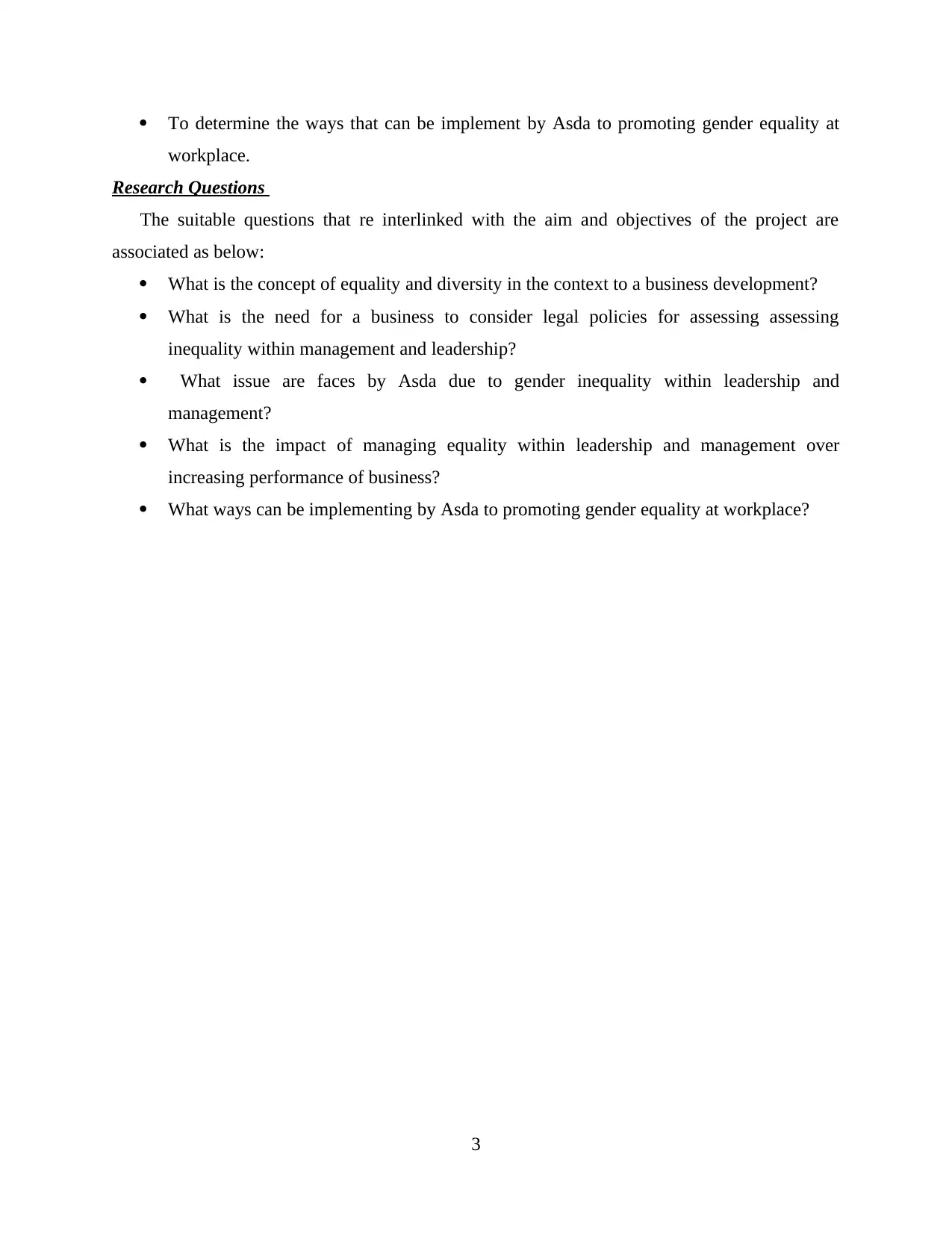
To determine the ways that can be implement by Asda to promoting gender equality at
workplace.
Research Questions
The suitable questions that re interlinked with the aim and objectives of the project are
associated as below:
What is the concept of equality and diversity in the context to a business development?
What is the need for a business to consider legal policies for assessing assessing
inequality within management and leadership?
What issue are faces by Asda due to gender inequality within leadership and
management?
What is the impact of managing equality within leadership and management over
increasing performance of business?
What ways can be implementing by Asda to promoting gender equality at workplace?
3
workplace.
Research Questions
The suitable questions that re interlinked with the aim and objectives of the project are
associated as below:
What is the concept of equality and diversity in the context to a business development?
What is the need for a business to consider legal policies for assessing assessing
inequality within management and leadership?
What issue are faces by Asda due to gender inequality within leadership and
management?
What is the impact of managing equality within leadership and management over
increasing performance of business?
What ways can be implementing by Asda to promoting gender equality at workplace?
3
⊘ This is a preview!⊘
Do you want full access?
Subscribe today to unlock all pages.

Trusted by 1+ million students worldwide
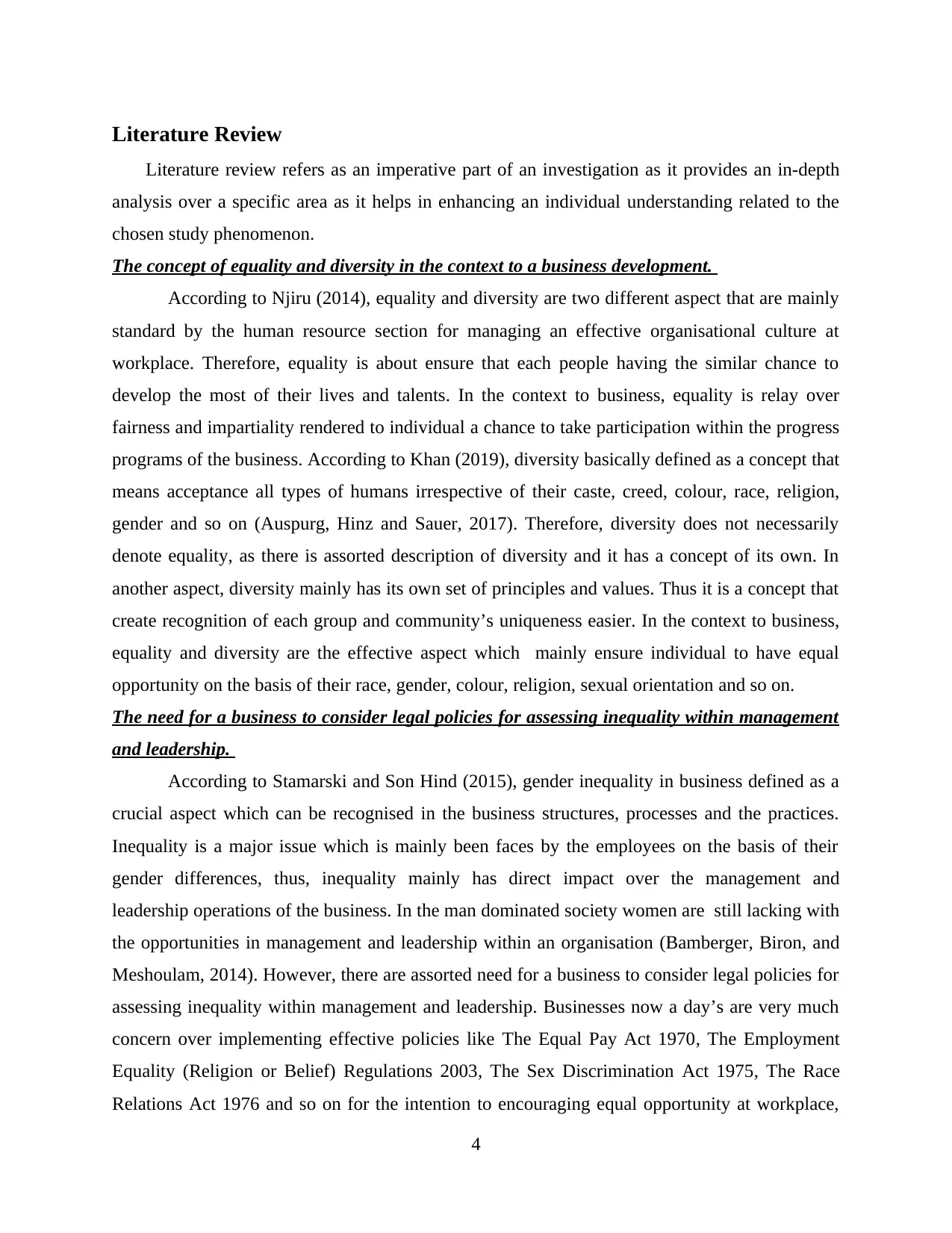
Literature Review
Literature review refers as an imperative part of an investigation as it provides an in-depth
analysis over a specific area as it helps in enhancing an individual understanding related to the
chosen study phenomenon.
The concept of equality and diversity in the context to a business development.
According to Njiru (2014), equality and diversity are two different aspect that are mainly
standard by the human resource section for managing an effective organisational culture at
workplace. Therefore, equality is about ensure that each people having the similar chance to
develop the most of their lives and talents. In the context to business, equality is relay over
fairness and impartiality rendered to individual a chance to take participation within the progress
programs of the business. According to Khan (2019), diversity basically defined as a concept that
means acceptance all types of humans irrespective of their caste, creed, colour, race, religion,
gender and so on (Auspurg, Hinz and Sauer, 2017). Therefore, diversity does not necessarily
denote equality, as there is assorted description of diversity and it has a concept of its own. In
another aspect, diversity mainly has its own set of principles and values. Thus it is a concept that
create recognition of each group and community’s uniqueness easier. In the context to business,
equality and diversity are the effective aspect which mainly ensure individual to have equal
opportunity on the basis of their race, gender, colour, religion, sexual orientation and so on.
The need for a business to consider legal policies for assessing inequality within management
and leadership.
According to Stamarski and Son Hind (2015), gender inequality in business defined as a
crucial aspect which can be recognised in the business structures, processes and the practices.
Inequality is a major issue which is mainly been faces by the employees on the basis of their
gender differences, thus, inequality mainly has direct impact over the management and
leadership operations of the business. In the man dominated society women are still lacking with
the opportunities in management and leadership within an organisation (Bamberger, Biron, and
Meshoulam, 2014). However, there are assorted need for a business to consider legal policies for
assessing inequality within management and leadership. Businesses now a day’s are very much
concern over implementing effective policies like The Equal Pay Act 1970, The Employment
Equality (Religion or Belief) Regulations 2003, The Sex Discrimination Act 1975, The Race
Relations Act 1976 and so on for the intention to encouraging equal opportunity at workplace,
4
Literature review refers as an imperative part of an investigation as it provides an in-depth
analysis over a specific area as it helps in enhancing an individual understanding related to the
chosen study phenomenon.
The concept of equality and diversity in the context to a business development.
According to Njiru (2014), equality and diversity are two different aspect that are mainly
standard by the human resource section for managing an effective organisational culture at
workplace. Therefore, equality is about ensure that each people having the similar chance to
develop the most of their lives and talents. In the context to business, equality is relay over
fairness and impartiality rendered to individual a chance to take participation within the progress
programs of the business. According to Khan (2019), diversity basically defined as a concept that
means acceptance all types of humans irrespective of their caste, creed, colour, race, religion,
gender and so on (Auspurg, Hinz and Sauer, 2017). Therefore, diversity does not necessarily
denote equality, as there is assorted description of diversity and it has a concept of its own. In
another aspect, diversity mainly has its own set of principles and values. Thus it is a concept that
create recognition of each group and community’s uniqueness easier. In the context to business,
equality and diversity are the effective aspect which mainly ensure individual to have equal
opportunity on the basis of their race, gender, colour, religion, sexual orientation and so on.
The need for a business to consider legal policies for assessing inequality within management
and leadership.
According to Stamarski and Son Hind (2015), gender inequality in business defined as a
crucial aspect which can be recognised in the business structures, processes and the practices.
Inequality is a major issue which is mainly been faces by the employees on the basis of their
gender differences, thus, inequality mainly has direct impact over the management and
leadership operations of the business. In the man dominated society women are still lacking with
the opportunities in management and leadership within an organisation (Bamberger, Biron, and
Meshoulam, 2014). However, there are assorted need for a business to consider legal policies for
assessing inequality within management and leadership. Businesses now a day’s are very much
concern over implementing effective policies like The Equal Pay Act 1970, The Employment
Equality (Religion or Belief) Regulations 2003, The Sex Discrimination Act 1975, The Race
Relations Act 1976 and so on for the intention to encouraging equal opportunity at workplace,
4
Paraphrase This Document
Need a fresh take? Get an instant paraphrase of this document with our AI Paraphraser
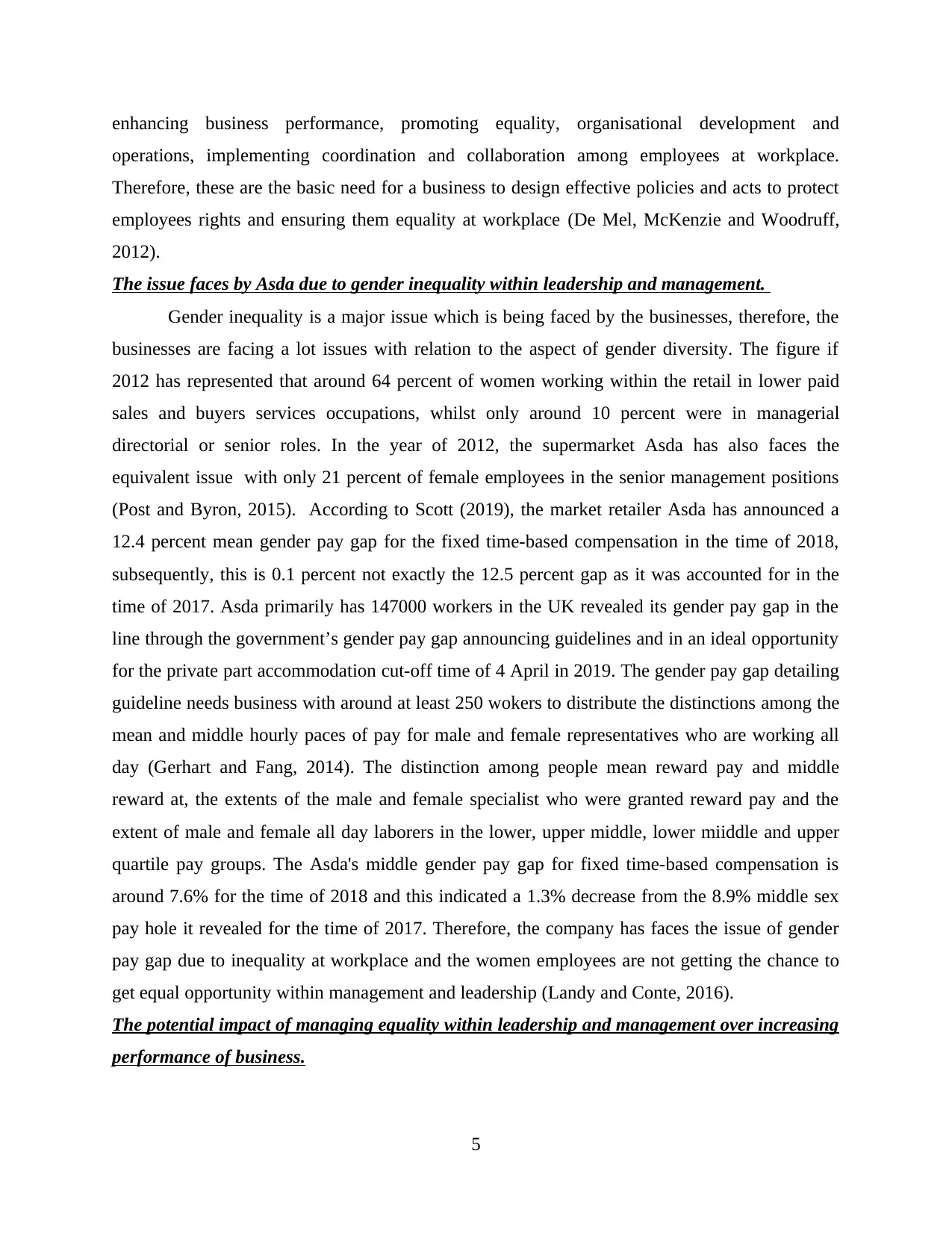
enhancing business performance, promoting equality, organisational development and
operations, implementing coordination and collaboration among employees at workplace.
Therefore, these are the basic need for a business to design effective policies and acts to protect
employees rights and ensuring them equality at workplace (De Mel, McKenzie and Woodruff,
2012).
The issue faces by Asda due to gender inequality within leadership and management.
Gender inequality is a major issue which is being faced by the businesses, therefore, the
businesses are facing a lot issues with relation to the aspect of gender diversity. The figure if
2012 has represented that around 64 percent of women working within the retail in lower paid
sales and buyers services occupations, whilst only around 10 percent were in managerial
directorial or senior roles. In the year of 2012, the supermarket Asda has also faces the
equivalent issue with only 21 percent of female employees in the senior management positions
(Post and Byron, 2015). According to Scott (2019), the market retailer Asda has announced a
12.4 percent mean gender pay gap for the fixed time-based compensation in the time of 2018,
subsequently, this is 0.1 percent not exactly the 12.5 percent gap as it was accounted for in the
time of 2017. Asda primarily has 147000 workers in the UK revealed its gender pay gap in the
line through the government’s gender pay gap announcing guidelines and in an ideal opportunity
for the private part accommodation cut-off time of 4 April in 2019. The gender pay gap detailing
guideline needs business with around at least 250 wokers to distribute the distinctions among the
mean and middle hourly paces of pay for male and female representatives who are working all
day (Gerhart and Fang, 2014). The distinction among people mean reward pay and middle
reward at, the extents of the male and female specialist who were granted reward pay and the
extent of male and female all day laborers in the lower, upper middle, lower miiddle and upper
quartile pay groups. The Asda's middle gender pay gap for fixed time-based compensation is
around 7.6% for the time of 2018 and this indicated a 1.3% decrease from the 8.9% middle sex
pay hole it revealed for the time of 2017. Therefore, the company has faces the issue of gender
pay gap due to inequality at workplace and the women employees are not getting the chance to
get equal opportunity within management and leadership (Landy and Conte, 2016).
The potential impact of managing equality within leadership and management over increasing
performance of business.
5
operations, implementing coordination and collaboration among employees at workplace.
Therefore, these are the basic need for a business to design effective policies and acts to protect
employees rights and ensuring them equality at workplace (De Mel, McKenzie and Woodruff,
2012).
The issue faces by Asda due to gender inequality within leadership and management.
Gender inequality is a major issue which is being faced by the businesses, therefore, the
businesses are facing a lot issues with relation to the aspect of gender diversity. The figure if
2012 has represented that around 64 percent of women working within the retail in lower paid
sales and buyers services occupations, whilst only around 10 percent were in managerial
directorial or senior roles. In the year of 2012, the supermarket Asda has also faces the
equivalent issue with only 21 percent of female employees in the senior management positions
(Post and Byron, 2015). According to Scott (2019), the market retailer Asda has announced a
12.4 percent mean gender pay gap for the fixed time-based compensation in the time of 2018,
subsequently, this is 0.1 percent not exactly the 12.5 percent gap as it was accounted for in the
time of 2017. Asda primarily has 147000 workers in the UK revealed its gender pay gap in the
line through the government’s gender pay gap announcing guidelines and in an ideal opportunity
for the private part accommodation cut-off time of 4 April in 2019. The gender pay gap detailing
guideline needs business with around at least 250 wokers to distribute the distinctions among the
mean and middle hourly paces of pay for male and female representatives who are working all
day (Gerhart and Fang, 2014). The distinction among people mean reward pay and middle
reward at, the extents of the male and female specialist who were granted reward pay and the
extent of male and female all day laborers in the lower, upper middle, lower miiddle and upper
quartile pay groups. The Asda's middle gender pay gap for fixed time-based compensation is
around 7.6% for the time of 2018 and this indicated a 1.3% decrease from the 8.9% middle sex
pay hole it revealed for the time of 2017. Therefore, the company has faces the issue of gender
pay gap due to inequality at workplace and the women employees are not getting the chance to
get equal opportunity within management and leadership (Landy and Conte, 2016).
The potential impact of managing equality within leadership and management over increasing
performance of business.
5
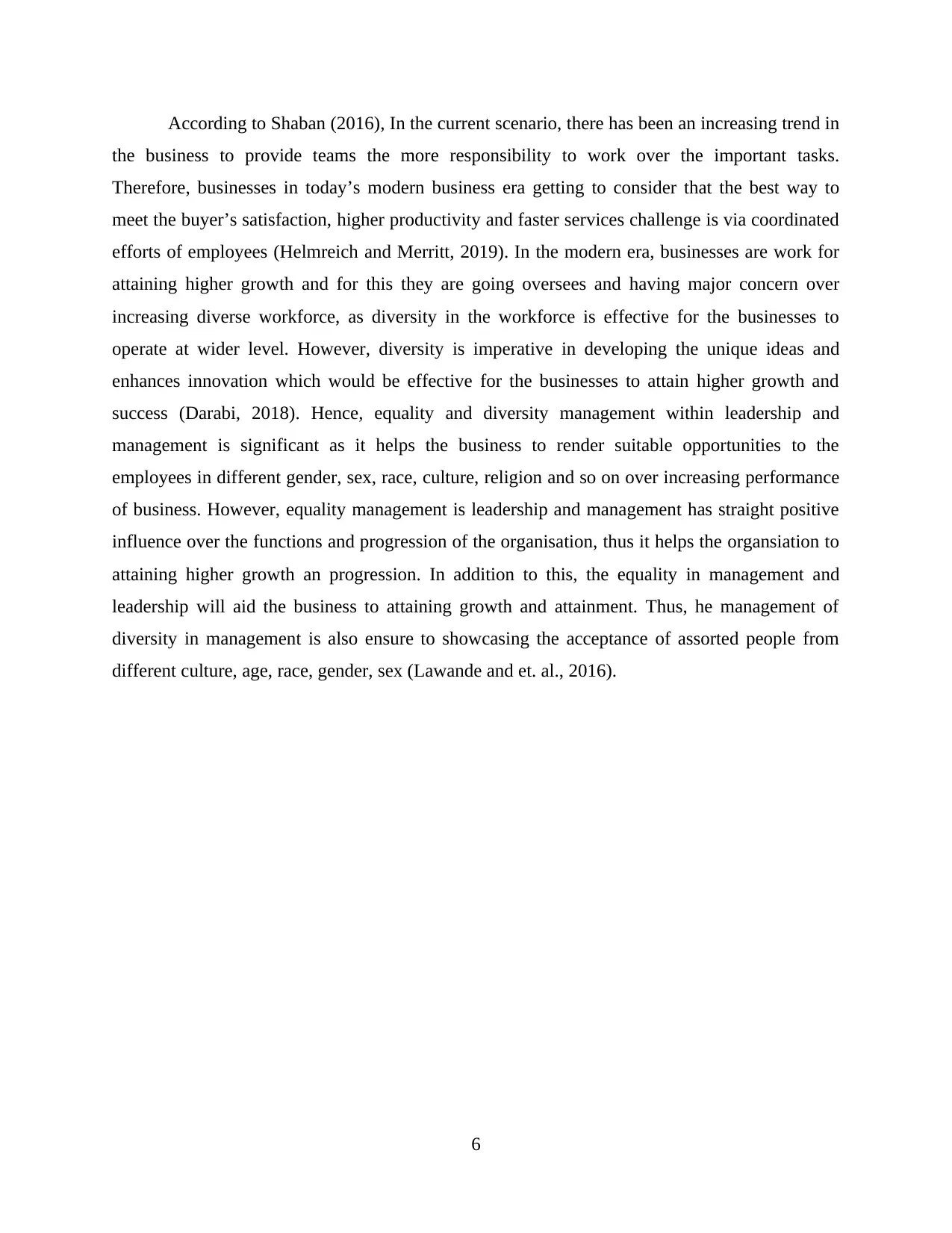
According to Shaban (2016), In the current scenario, there has been an increasing trend in
the business to provide teams the more responsibility to work over the important tasks.
Therefore, businesses in today’s modern business era getting to consider that the best way to
meet the buyer’s satisfaction, higher productivity and faster services challenge is via coordinated
efforts of employees (Helmreich and Merritt, 2019). In the modern era, businesses are work for
attaining higher growth and for this they are going oversees and having major concern over
increasing diverse workforce, as diversity in the workforce is effective for the businesses to
operate at wider level. However, diversity is imperative in developing the unique ideas and
enhances innovation which would be effective for the businesses to attain higher growth and
success (Darabi, 2018). Hence, equality and diversity management within leadership and
management is significant as it helps the business to render suitable opportunities to the
employees in different gender, sex, race, culture, religion and so on over increasing performance
of business. However, equality management is leadership and management has straight positive
influence over the functions and progression of the organisation, thus it helps the organsiation to
attaining higher growth an progression. In addition to this, the equality in management and
leadership will aid the business to attaining growth and attainment. Thus, he management of
diversity in management is also ensure to showcasing the acceptance of assorted people from
different culture, age, race, gender, sex (Lawande and et. al., 2016).
6
the business to provide teams the more responsibility to work over the important tasks.
Therefore, businesses in today’s modern business era getting to consider that the best way to
meet the buyer’s satisfaction, higher productivity and faster services challenge is via coordinated
efforts of employees (Helmreich and Merritt, 2019). In the modern era, businesses are work for
attaining higher growth and for this they are going oversees and having major concern over
increasing diverse workforce, as diversity in the workforce is effective for the businesses to
operate at wider level. However, diversity is imperative in developing the unique ideas and
enhances innovation which would be effective for the businesses to attain higher growth and
success (Darabi, 2018). Hence, equality and diversity management within leadership and
management is significant as it helps the business to render suitable opportunities to the
employees in different gender, sex, race, culture, religion and so on over increasing performance
of business. However, equality management is leadership and management has straight positive
influence over the functions and progression of the organisation, thus it helps the organsiation to
attaining higher growth an progression. In addition to this, the equality in management and
leadership will aid the business to attaining growth and attainment. Thus, he management of
diversity in management is also ensure to showcasing the acceptance of assorted people from
different culture, age, race, gender, sex (Lawande and et. al., 2016).
6
⊘ This is a preview!⊘
Do you want full access?
Subscribe today to unlock all pages.

Trusted by 1+ million students worldwide
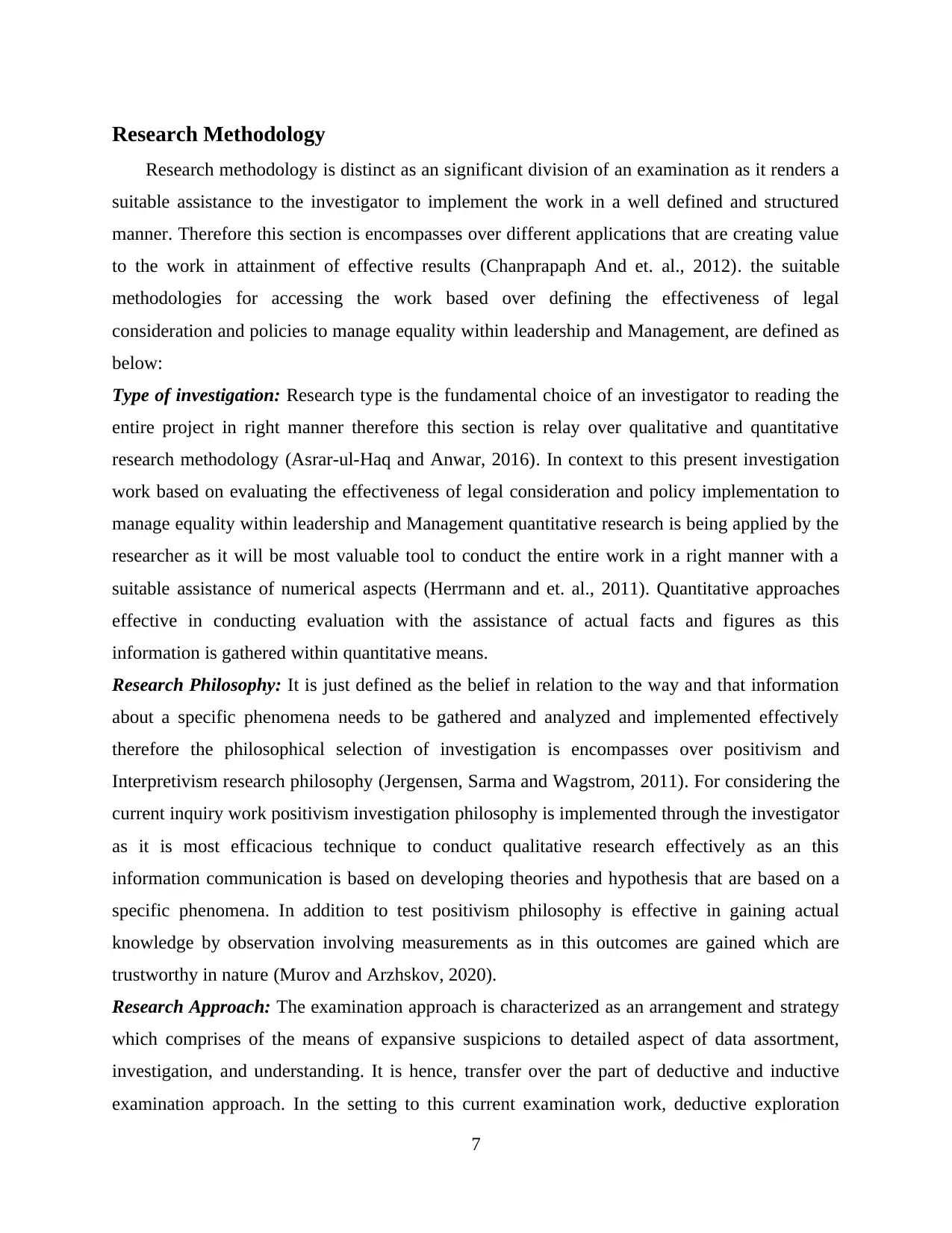
Research Methodology
Research methodology is distinct as an significant division of an examination as it renders a
suitable assistance to the investigator to implement the work in a well defined and structured
manner. Therefore this section is encompasses over different applications that are creating value
to the work in attainment of effective results (Chanprapaph And et. al., 2012). the suitable
methodologies for accessing the work based over defining the effectiveness of legal
consideration and policies to manage equality within leadership and Management, are defined as
below:
Type of investigation: Research type is the fundamental choice of an investigator to reading the
entire project in right manner therefore this section is relay over qualitative and quantitative
research methodology (Asrar-ul-Haq and Anwar, 2016). In context to this present investigation
work based on evaluating the effectiveness of legal consideration and policy implementation to
manage equality within leadership and Management quantitative research is being applied by the
researcher as it will be most valuable tool to conduct the entire work in a right manner with a
suitable assistance of numerical aspects (Herrmann and et. al., 2011). Quantitative approaches
effective in conducting evaluation with the assistance of actual facts and figures as this
information is gathered within quantitative means.
Research Philosophy: It is just defined as the belief in relation to the way and that information
about a specific phenomena needs to be gathered and analyzed and implemented effectively
therefore the philosophical selection of investigation is encompasses over positivism and
Interpretivism research philosophy (Jergensen, Sarma and Wagstrom, 2011). For considering the
current inquiry work positivism investigation philosophy is implemented through the investigator
as it is most efficacious technique to conduct qualitative research effectively as an this
information communication is based on developing theories and hypothesis that are based on a
specific phenomena. In addition to test positivism philosophy is effective in gaining actual
knowledge by observation involving measurements as in this outcomes are gained which are
trustworthy in nature (Murov and Arzhskov, 2020).
Research Approach: The examination approach is characterized as an arrangement and strategy
which comprises of the means of expansive suspicions to detailed aspect of data assortment,
investigation, and understanding. It is hence, transfer over the part of deductive and inductive
examination approach. In the setting to this current examination work, deductive exploration
7
Research methodology is distinct as an significant division of an examination as it renders a
suitable assistance to the investigator to implement the work in a well defined and structured
manner. Therefore this section is encompasses over different applications that are creating value
to the work in attainment of effective results (Chanprapaph And et. al., 2012). the suitable
methodologies for accessing the work based over defining the effectiveness of legal
consideration and policies to manage equality within leadership and Management, are defined as
below:
Type of investigation: Research type is the fundamental choice of an investigator to reading the
entire project in right manner therefore this section is relay over qualitative and quantitative
research methodology (Asrar-ul-Haq and Anwar, 2016). In context to this present investigation
work based on evaluating the effectiveness of legal consideration and policy implementation to
manage equality within leadership and Management quantitative research is being applied by the
researcher as it will be most valuable tool to conduct the entire work in a right manner with a
suitable assistance of numerical aspects (Herrmann and et. al., 2011). Quantitative approaches
effective in conducting evaluation with the assistance of actual facts and figures as this
information is gathered within quantitative means.
Research Philosophy: It is just defined as the belief in relation to the way and that information
about a specific phenomena needs to be gathered and analyzed and implemented effectively
therefore the philosophical selection of investigation is encompasses over positivism and
Interpretivism research philosophy (Jergensen, Sarma and Wagstrom, 2011). For considering the
current inquiry work positivism investigation philosophy is implemented through the investigator
as it is most efficacious technique to conduct qualitative research effectively as an this
information communication is based on developing theories and hypothesis that are based on a
specific phenomena. In addition to test positivism philosophy is effective in gaining actual
knowledge by observation involving measurements as in this outcomes are gained which are
trustworthy in nature (Murov and Arzhskov, 2020).
Research Approach: The examination approach is characterized as an arrangement and strategy
which comprises of the means of expansive suspicions to detailed aspect of data assortment,
investigation, and understanding. It is hence, transfer over the part of deductive and inductive
examination approach. In the setting to this current examination work, deductive exploration
7
Paraphrase This Document
Need a fresh take? Get an instant paraphrase of this document with our AI Paraphraser
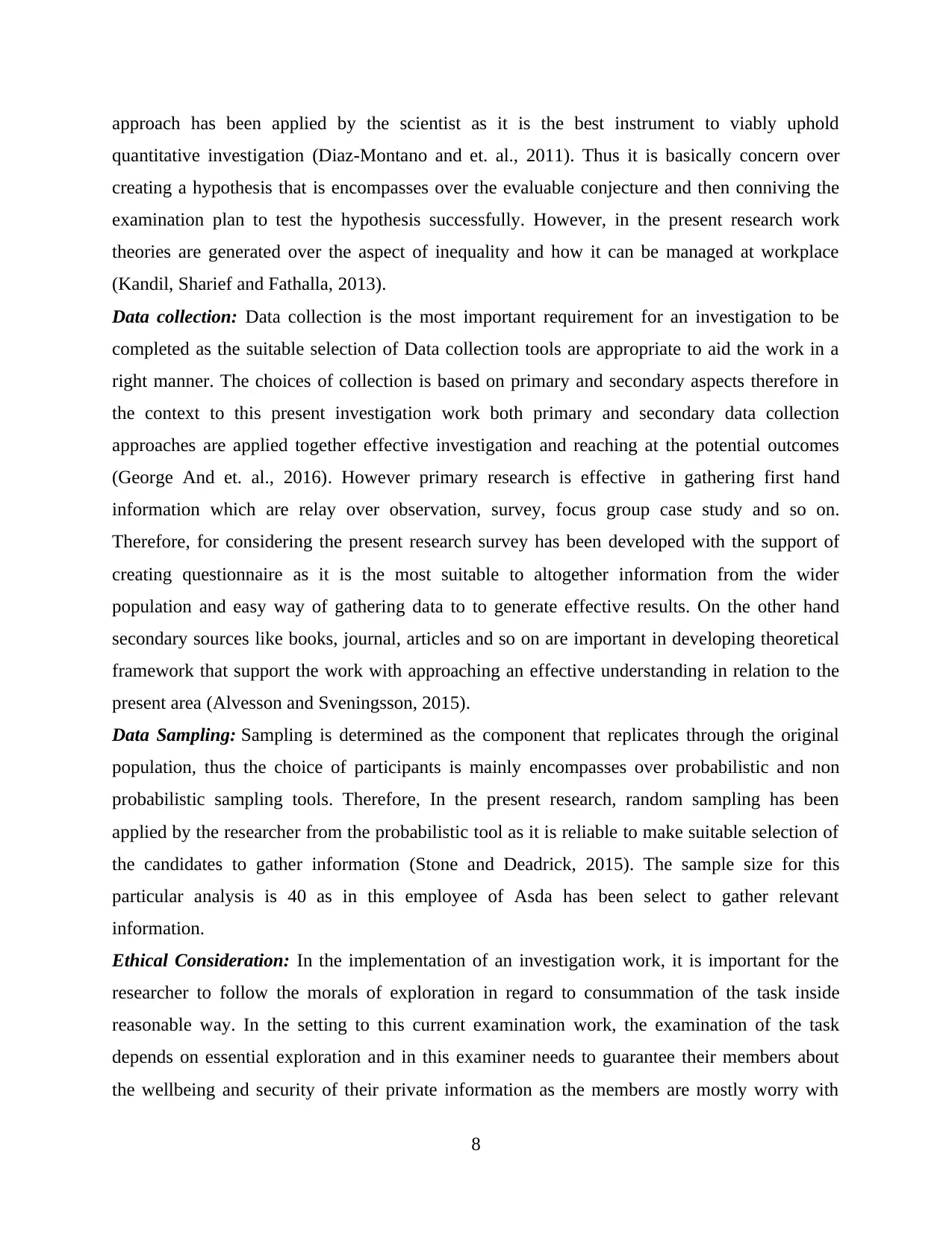
approach has been applied by the scientist as it is the best instrument to viably uphold
quantitative investigation (Diaz-Montano and et. al., 2011). Thus it is basically concern over
creating a hypothesis that is encompasses over the evaluable conjecture and then conniving the
examination plan to test the hypothesis successfully. However, in the present research work
theories are generated over the aspect of inequality and how it can be managed at workplace
(Kandil, Sharief and Fathalla, 2013).
Data collection: Data collection is the most important requirement for an investigation to be
completed as the suitable selection of Data collection tools are appropriate to aid the work in a
right manner. The choices of collection is based on primary and secondary aspects therefore in
the context to this present investigation work both primary and secondary data collection
approaches are applied together effective investigation and reaching at the potential outcomes
(George And et. al., 2016). However primary research is effective in gathering first hand
information which are relay over observation, survey, focus group case study and so on.
Therefore, for considering the present research survey has been developed with the support of
creating questionnaire as it is the most suitable to altogether information from the wider
population and easy way of gathering data to to generate effective results. On the other hand
secondary sources like books, journal, articles and so on are important in developing theoretical
framework that support the work with approaching an effective understanding in relation to the
present area (Alvesson and Sveningsson, 2015).
Data Sampling: Sampling is determined as the component that replicates through the original
population, thus the choice of participants is mainly encompasses over probabilistic and non
probabilistic sampling tools. Therefore, In the present research, random sampling has been
applied by the researcher from the probabilistic tool as it is reliable to make suitable selection of
the candidates to gather information (Stone and Deadrick, 2015). The sample size for this
particular analysis is 40 as in this employee of Asda has been select to gather relevant
information.
Ethical Consideration: In the implementation of an investigation work, it is important for the
researcher to follow the morals of exploration in regard to consummation of the task inside
reasonable way. In the setting to this current examination work, the examination of the task
depends on essential exploration and in this examiner needs to guarantee their members about
the wellbeing and security of their private information as the members are mostly worry with
8
quantitative investigation (Diaz-Montano and et. al., 2011). Thus it is basically concern over
creating a hypothesis that is encompasses over the evaluable conjecture and then conniving the
examination plan to test the hypothesis successfully. However, in the present research work
theories are generated over the aspect of inequality and how it can be managed at workplace
(Kandil, Sharief and Fathalla, 2013).
Data collection: Data collection is the most important requirement for an investigation to be
completed as the suitable selection of Data collection tools are appropriate to aid the work in a
right manner. The choices of collection is based on primary and secondary aspects therefore in
the context to this present investigation work both primary and secondary data collection
approaches are applied together effective investigation and reaching at the potential outcomes
(George And et. al., 2016). However primary research is effective in gathering first hand
information which are relay over observation, survey, focus group case study and so on.
Therefore, for considering the present research survey has been developed with the support of
creating questionnaire as it is the most suitable to altogether information from the wider
population and easy way of gathering data to to generate effective results. On the other hand
secondary sources like books, journal, articles and so on are important in developing theoretical
framework that support the work with approaching an effective understanding in relation to the
present area (Alvesson and Sveningsson, 2015).
Data Sampling: Sampling is determined as the component that replicates through the original
population, thus the choice of participants is mainly encompasses over probabilistic and non
probabilistic sampling tools. Therefore, In the present research, random sampling has been
applied by the researcher from the probabilistic tool as it is reliable to make suitable selection of
the candidates to gather information (Stone and Deadrick, 2015). The sample size for this
particular analysis is 40 as in this employee of Asda has been select to gather relevant
information.
Ethical Consideration: In the implementation of an investigation work, it is important for the
researcher to follow the morals of exploration in regard to consummation of the task inside
reasonable way. In the setting to this current examination work, the examination of the task
depends on essential exploration and in this examiner needs to guarantee their members about
the wellbeing and security of their private information as the members are mostly worry with
8
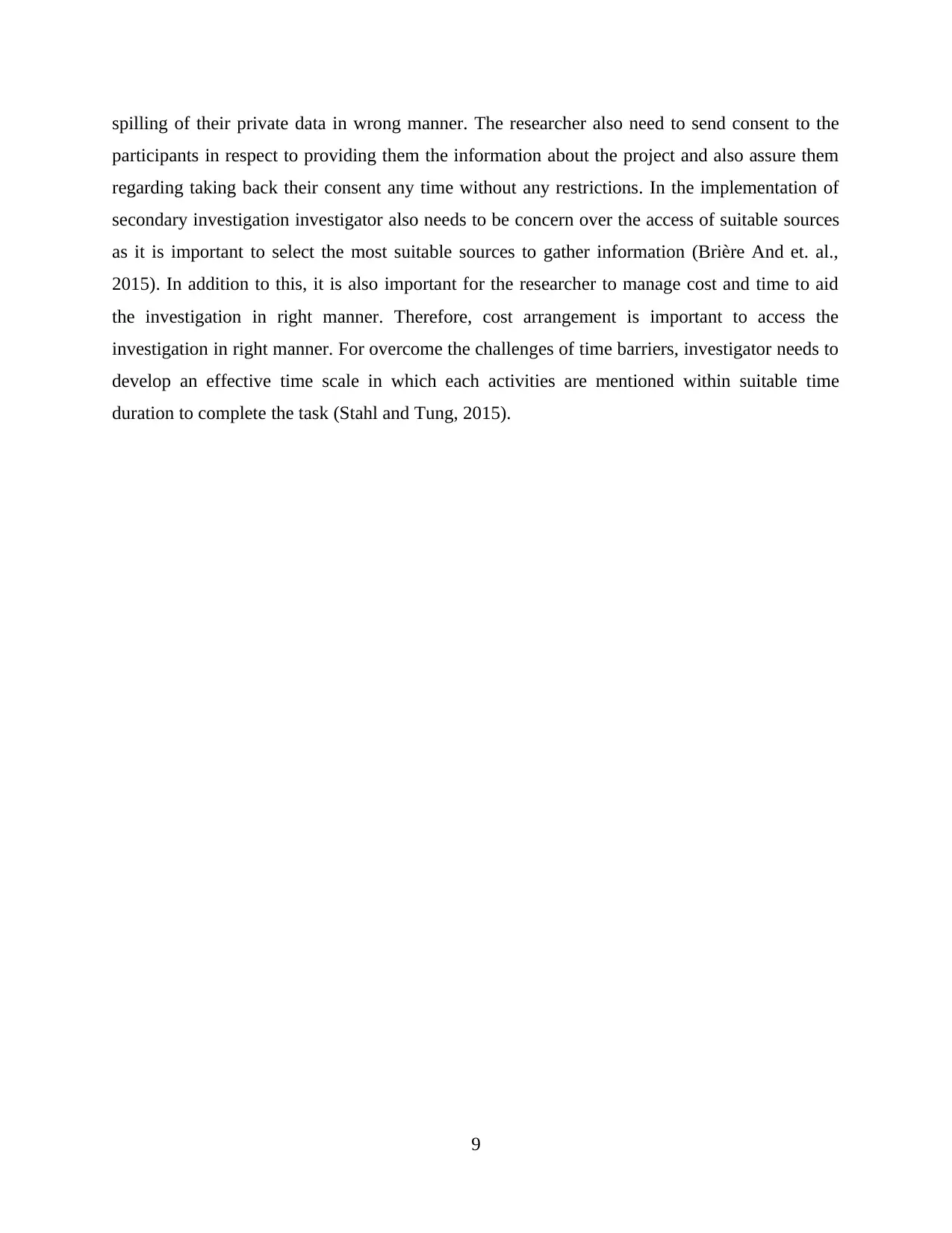
spilling of their private data in wrong manner. The researcher also need to send consent to the
participants in respect to providing them the information about the project and also assure them
regarding taking back their consent any time without any restrictions. In the implementation of
secondary investigation investigator also needs to be concern over the access of suitable sources
as it is important to select the most suitable sources to gather information (Brière And et. al.,
2015). In addition to this, it is also important for the researcher to manage cost and time to aid
the investigation in right manner. Therefore, cost arrangement is important to access the
investigation in right manner. For overcome the challenges of time barriers, investigator needs to
develop an effective time scale in which each activities are mentioned within suitable time
duration to complete the task (Stahl and Tung, 2015).
9
participants in respect to providing them the information about the project and also assure them
regarding taking back their consent any time without any restrictions. In the implementation of
secondary investigation investigator also needs to be concern over the access of suitable sources
as it is important to select the most suitable sources to gather information (Brière And et. al.,
2015). In addition to this, it is also important for the researcher to manage cost and time to aid
the investigation in right manner. Therefore, cost arrangement is important to access the
investigation in right manner. For overcome the challenges of time barriers, investigator needs to
develop an effective time scale in which each activities are mentioned within suitable time
duration to complete the task (Stahl and Tung, 2015).
9
⊘ This is a preview!⊘
Do you want full access?
Subscribe today to unlock all pages.

Trusted by 1+ million students worldwide
1 out of 34
Related Documents
Your All-in-One AI-Powered Toolkit for Academic Success.
+13062052269
info@desklib.com
Available 24*7 on WhatsApp / Email
![[object Object]](/_next/static/media/star-bottom.7253800d.svg)
Unlock your academic potential
Copyright © 2020–2025 A2Z Services. All Rights Reserved. Developed and managed by ZUCOL.





